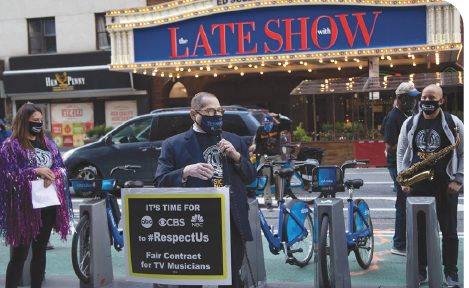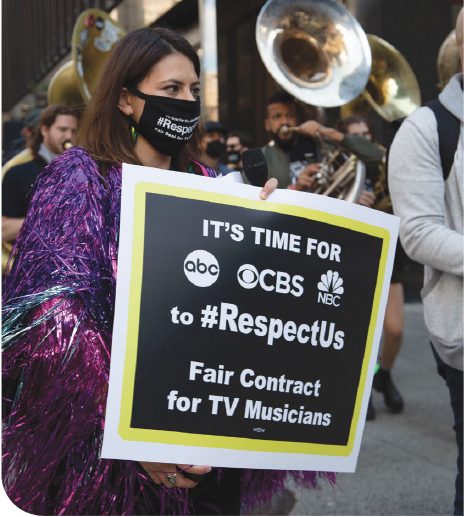I am pleased to report that on October 22, 2020, after years of false starts, interruptions, and delays, the Federation reached agreement with representatives of CBS, NBC, and ABC for a successor Television Videotape Agreement, subject to ratification by the members.
Negotiations for this agreement spread over four years. The previous agreement expired on February 2, 2016, but was extended indefinitely pending a successor agreement. These negotiations presented some of the most difficult challenges the Federation has ever confronted. From the beginning, we faced employers who refused to bargain over streaming residuals, who wanted to reach an agreement that simply was unfair to musicians. Network representatives never really wanted to make meaningful improvements to our livelihoods. When they eventually relented and agreed to discuss streaming residuals, the employers attempted to deny coverage to a large segment of the bargaining unit—guest artists, background musicians, and music preparation personnel—proposals we would never accept, and which we roundly and soundly rejected.
Our rank and file members and negotiating team hammered home repeatedly the fundamental inequity of their refusal to pay streaming residuals to musicians—residuals they pay to members of other talent unions—and their failure to ensure that musicians will qualify for continuous health care coverage. Buoyed by extensive concerted activity, we persevered and reached an acceptable agreement. While we did not accomplish all our objectives, we did make considerable progress.
Although we have not achieved full parity with other unions in residual streaming, we did succeed in obtaining new contract language providing for a residual when content from live television programs is exhibited on an advertiser-supported streaming-on-demand (known as Advertising Video on Demand, or AVOD) platform after a seven-day free window. Despite fierce resistance from the networks, the Federation fought to ensure that all musicians involved in production of streamed shows—including house bands, guest artist musicians, back-up musicians, and music preparation personnel—would receive an additional 2% of the program rate for each of two 26-week periods of streamed exhibition. After expiration of two 26-week periods, musicians will receive a pro-rata share in 1.2% of the streamed program’s AVOD receipts.
In addition, the networks agreed to apply the contract’s regular wage and benefit rates to services performed on certain High Budget Subscription Video on Demand (SVOD) programs, ending the insidious practice of free negotiation. If ratified, wage rates in the agreement will be increased by 2% each year for a three-year term. Health and welfare daily contribution rates will increase by $5 in year one, and by an additional $5 in year three. The networks also agreed to increase their contributions for paid permanent download content from 1% to 1.5% of 20% of distributor’s gross for the first 100,000 units, and from 1.9% to 2.9% of 20% thereafter. Another new feature is payments to the AFM and Employers’ Pension Fund on an unallocated basis for licenses to secondary digital channels. These improvements are significant. The new AVOD residual language is a fundamental, structural contract change that can be improved upon in future negotiations. Moreover, this deal will result in long overdue wage increases that are compounded by the new AVOD streaming payments.
The path to this agreement was arduous. The networks put up every roadblock they could. In the face of this reality, our approach was steadfast in protecting the contributions our great musicians make to the television industry and pragmatic toward seeking new benefits for our constituency and our pension fund. While we have a long road ahead and much more progress to make, this comprehensive package addresses a number of critical issues, not the least of which is the wage stagnation of the past several years owing to the networks’ refusal to negotiate and provide streaming residual counterproposals. We had to fight long and hard to get serious discussions on streaming started at all. Once that happened, and when musicians from our shows hit the street and generated heat, the pieces began to fall into place.
I cannot praise too highly the solidarity, hard work, and enormous time investment of all the musicians in the #RespectUs campaign. Actions included wearing #RespectUs facemasks at their workplace, NYC rally and march, and helping to get public recognition for the contract from late night hosts James Corden and Stephen Colbert. Without the actions from members fighting to win a better contract, we would not have won what we did.
We benefitted from the invaluable input and activism from Local 802 and Local 47 musicians who perform on the various late-night shows with James Corden, Stephen Colbert, Jimmy Kimmel, Jimmy Fallon, and Seth Meyers, as well as variety show musicians performing with Dancing with the Stars, The Voice, and Saturday Night Live. Numerous freelance bargaining unit musicians participated in Zoom meetings and negotiations. We were also assisted by local union officers Ed Malaga (IEB and Washington, DC Local 161-710), Terry Jares (IEB and Chicago Local 10-208), Pat Hollenbeck (Boston Local 9-535), Andy Schwartz (New York Local 802), Rick Baptist (Los Angeles Local 47), Dean Rolando (Chicago Local 10-208), and Nashville RMA representative Danny Rader.
I offer my most sincere thanks to the members of the Federation’s negotiating team, which consisted of International Vice President Bruce Fife, Vice President from Canada Alan Willaert, Secretary-Treasurer Jay Blumenthal, International Executive Board members John Acosta (Local 47 Los Angeles) and Dave Pomeroy (Nashville Local 257), RMA President Marc Sazer, and rank and file representative Jason Poss, with assistance from AFM Counsel Jennifer Garner and Russ Naymark, EMSD Director Pat Varriale and Assistant Director John Painting, Contract Administrator Mary Beth Blakey, Organizing Director Michael Manley and Lead Organizer Alex Tindal Wiesendanger, Communications Director Antoinette Follett, and Local 47 Organizer Jefferson Kemper.
We cannot afford to relax and ease the pressure. We will meet regularly with the employers to continue discussions concerning workplace issues and the equity we seek. Further contract improvements, particularly in streaming residuals, will likely result if we maintain and build upon the momentum of our fairness campaign.
Next up—the Sound Recording Labor Agreement, with our old friends, the major record labels.



















